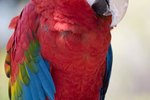
From the days of ancient Egypt through the early 20th century, pigeons were used regularly to carry messages and small packets, and to deliver news. In the 1800s and 1900s they were heavily used to relay strategic military information between posts; such use may exist today. For sure, hobbyists or pigeon fanciers are still raising carrier pigeons, also known as homing pigeons.
History of Pigeon Post
The use of carrier pigeons to deliver messages is recorded in ancient Egyptian hieroglyphics that indicate the birds were domesticated more than 5,000 years ago. Descendants of rock pigeons native to Europe, North Africa and South Asia, carrier pigeons were also used in ancient India, China and Greece, and were considered the fastest mode of communication from the Dark Ages and Middle Ages. Carrier pigeons remained the most efficient means of delivering messages and information for centuries, with bankers and stockbrokers relying heavily on pigeon post until the invention of the telegraph in the mid 19th century.
Military Use of Pigeons
Long used as a means of relaying military information, carrier pigeons continued to be used in military operations even after the invention of the telegraph and radio. Because telegraph communications could be easily intercepted or cut off, pigeon post played a critical part in the military operations of World War I. Pigeons continued to deliver military messages during World War II during times of radio silence. Pigeons served in aerial reconnaissance missions, carrying small cameras over enemy lines to capture photos. Pigeons continued to serve the military in Europe through the late 20th century, A 2008 "New York Times" article says the use of pigeons continues in Middle East war zones, where pigeons serve to signal the presence of military troops.
Training Pigeons
Today’s methods for training racing pigeons are much the same as those used in training the messenger pigeon of years gone by. Birds begin training when they are 6 to 12 weeks old. When placed in a new loft, the young birds are confined for a few days to allow it to become used to its new home. They are allowed to venture out in a confined area at the same time each day, going a bit further each time before they return on their own to the loft to be fed. This conditions the birds to associate feeding time with returning home to the loft. Once the young birds are conditioned to return to the loft for food, they are taken with older, trained birds away from the loft a short distance and released to fly back. Over time, distance is increased and older birds no longer accompany the younger birds.
Homing and Distance
Carrier pigeons are famous for finding their way home over great distances, covering hundreds of miles to get back to the loft from an unfamiliar point of release. The Cornell Lab of Ornithology publication "BirdScope," in Laura Erickson's 2008 article “Bird of Paradox: Rock Pigeon May Be More Helpful Than We Realize,” explains that pigeons use the earth’s magnetic field, along with several other cues, for orientation. Pigeons also use their sense of smell, Erickson adds, along with star patterns, the angle of the sun and polarized light as clues to finding their way home. If it can be helped, pigeons are not to be released in bad weather conditions including rain, fog or snow, which can cause the birds disorientation.
References
- American Racing Pigeon Union: The Origin and History of American Racing Pigeon Union
- World of Wings: Pigeons in Military History
- Americans in Wartime Museum: WWII Carrier Pigeon Finally Delivers Secret Message
- National Museum of the Air Force: "Stumpy" John Silver: Heroic Winged Messenger
- American Racing Pigeon Union: Understanding How to Read a Pigeon Band
- University of Minnesota: Media History Project; Pigeon Post
- The Navy Department Library: Instructions on Reception, Care and Training of Homing Pigeons in Newly Installed Lofts at U.S. Navy Air Bases
- Cornell Lab of Ornithology: Bird of Paradox: Rock Pigeon May Be More Helpful Than We Realize
- The New York Times: As Militias Roam Alleys, Iraqi Army Takes Brunt
- The Pigeon Insider: Pigeon Training Methods From Hilsea Lofts
Photo Credits
-
Stockbyte/Stockbyte/Getty Images
Writer Bio
Christy Ayala writes about recreation, sports, aquatics, healthy living, family and parenting, language development, organizational change, pets and animals. Ayala holds a master's degree in recreation administration from Aurora University’s George Williams College, a graduate certificate in organizational change from Hawaii Pacific University and a bachelor's degree in Spanish from the University of Missouri, St. Louis.




